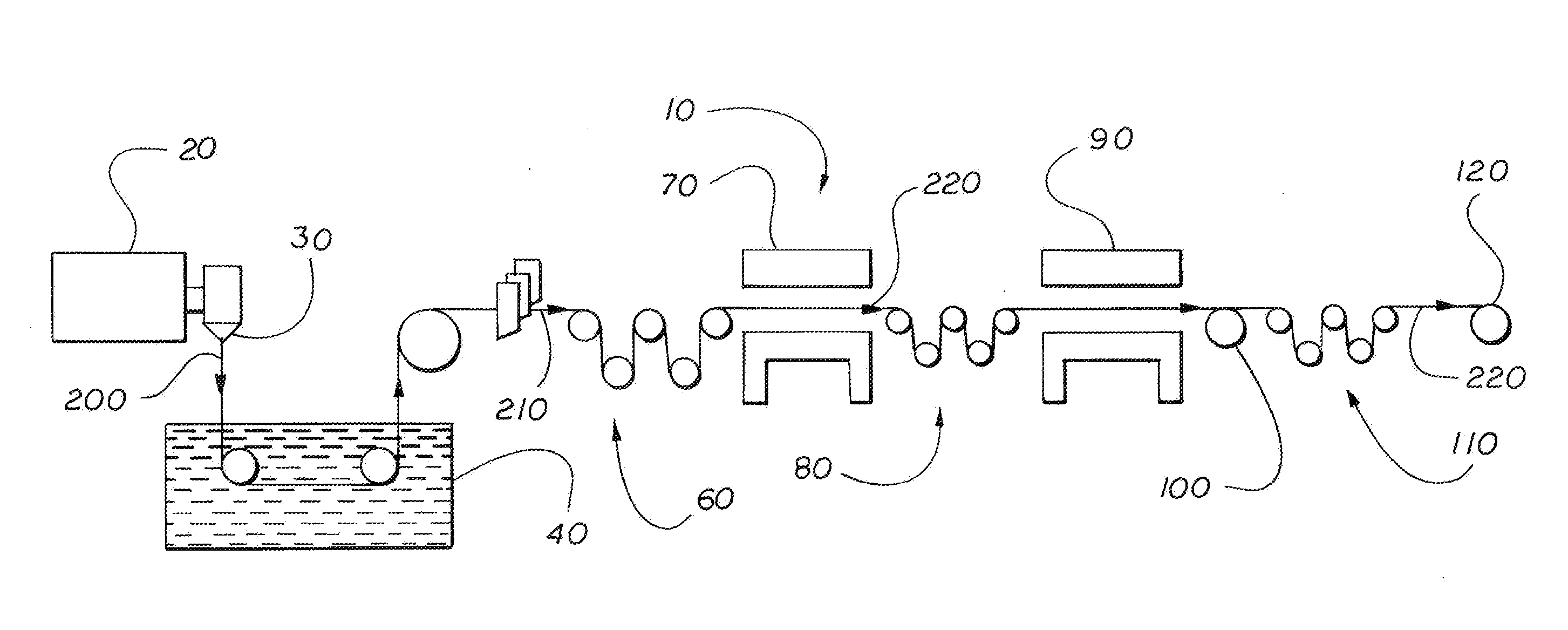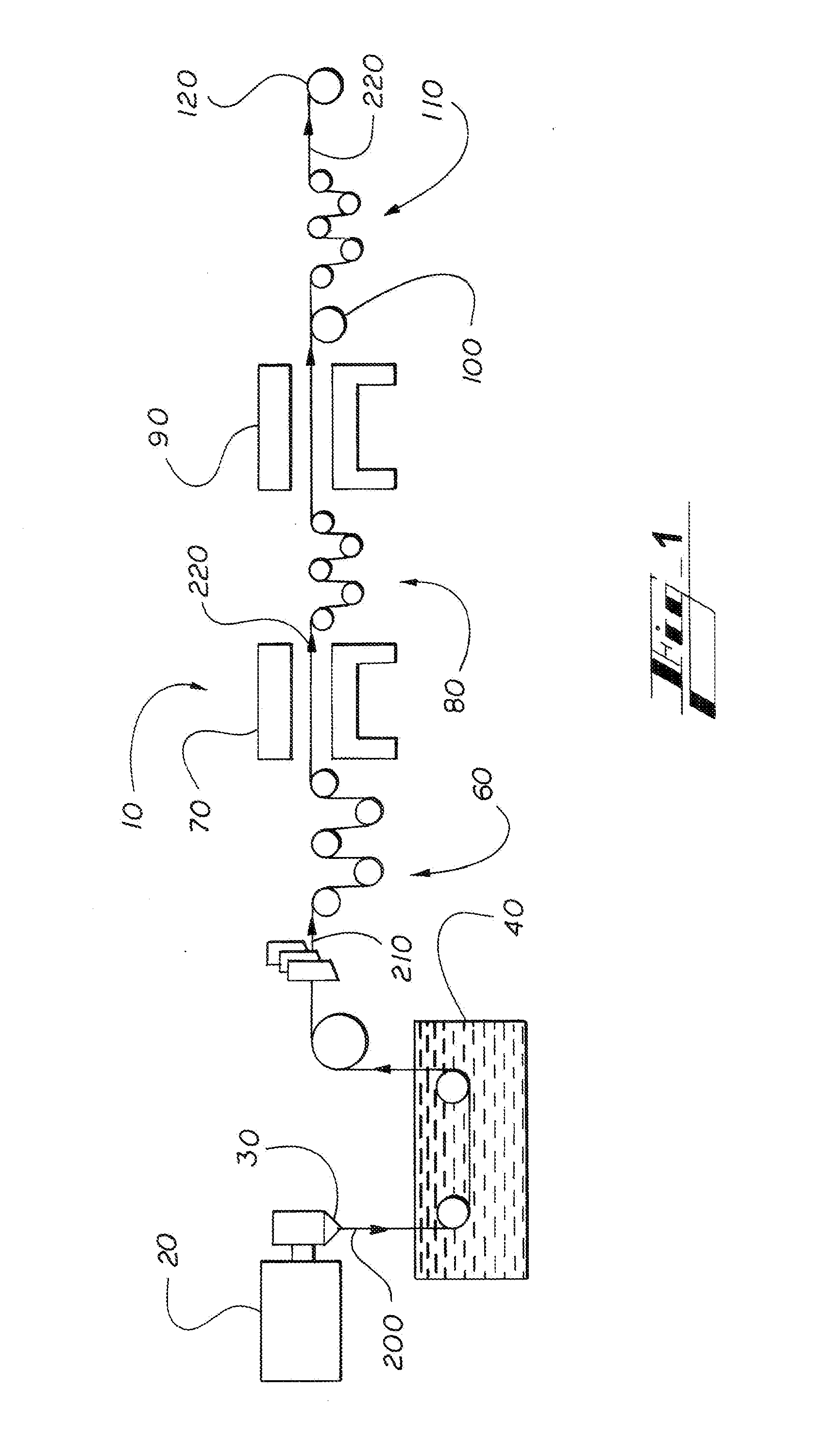Polypropylene Yarn Having Increased Young's Modulus And Method Of Making Same
a technology of polypropylene yarn and young's modulus, which is applied in the field of polypropylene yarn, can solve the problems of insufficient strength of conventionally manufactured polypropylene slit film tape for certain woven fabric applications, and inability to meet the needs of woven fabric applications
- Summary
- Abstract
- Description
- Claims
- Application Information
AI Technical Summary
Benefits of technology
Problems solved by technology
Method used
Image
Examples
example 1
[0139]A 4600 Denier fibrillated slit tape yarn was made in accordance with the process described above comprising a melt blended admixture of about 93 wt. % polypropylene homopolymer, about 5 wt. % Vistamaxx 6102 and about 2 wt. % carbon black. The draw ratio employed was 12.5:1. Also, a conventional 4600 Denier fibrillated slit tape yarn comprising 98% polypropylene homopolymer and about 2 wt. % carbon black was made using the process described above. The draw ratio employed was 6:1. Young's modulus was determined for each yarn in accordance with ASTM D2256. FIG. 2 is a graph showing the results of the test. It was determined that the conventional polypropylene yarn had a Young's modulus of 3.5 GPa, whereas the inventive yarn had a Young's modulus of 6.9 GPa, an improvement of 97.1%.
[0140]The tensile strength was also determined for these yarns during the determination of Young's modulus. The ultimate elongation of the inventive yarn was approximately 5%. Table 2 provides the resul...
example 2
[0142]A plain weave fabric was made employing 680 denier tape yarn made in accordance with the present invention. The tape yarn comprised, by weight of the extruded yarn, 92.8% polypropylene resin, 5% VISTAMAXX 6201, 2% calcium carbonate, and 0.2% carbon black. The tape was formed with a draw ratio of 8:1 and had a 0.002 inch thickness and 0.060 width. The tape was employed in both the warp and weft directions of the fabric. The fabric had 15.7 ends / inch and 14.2 picks / inch. The fabric met the standards listed in Table 1.
example 3
[0143]A 1000 Denier yarn having an oval-shaped cross-section was made in accordance with the process described above comprising a melt blended admixture of about 93 wt. % polypropylene homopolymer, about 5 wt. % Vistamaxx 6102 and about 2 wt. % carbon black. The draw ratio employed was 12:1. Also, a conventional 1000 Denier yarn having an oval-shaped cross-section comprising 98% polypropylene homopolymer and about 2 wt. % carbon black was made using the process described above. The draw ratio employed was 8:1. Young's modulus was determined for each yarn in accordance with ASTM D2256. FIG. 3 is a graph showing the results of the test. It was determined that the conventional 1000 Denier polypropylene yarn had a Young's modulus of 4.03 GPa, whereas the inventive 1000 Denier yarn had a Young's modulus of 5.73 GPa, an improvement of 42.2%. The tensile strength was also determined for these yarns during the determination of Young's modulus. Conventional 1000 Denier yarn had a tensile of ...
PUM
| Property | Measurement | Unit |
|---|---|---|
| Young's modulus | aaaaa | aaaaa |
| diameters | aaaaa | aaaaa |
| width | aaaaa | aaaaa |
Abstract
Description
Claims
Application Information
 Login to View More
Login to View More - R&D
- Intellectual Property
- Life Sciences
- Materials
- Tech Scout
- Unparalleled Data Quality
- Higher Quality Content
- 60% Fewer Hallucinations
Browse by: Latest US Patents, China's latest patents, Technical Efficacy Thesaurus, Application Domain, Technology Topic, Popular Technical Reports.
© 2025 PatSnap. All rights reserved.Legal|Privacy policy|Modern Slavery Act Transparency Statement|Sitemap|About US| Contact US: help@patsnap.com



